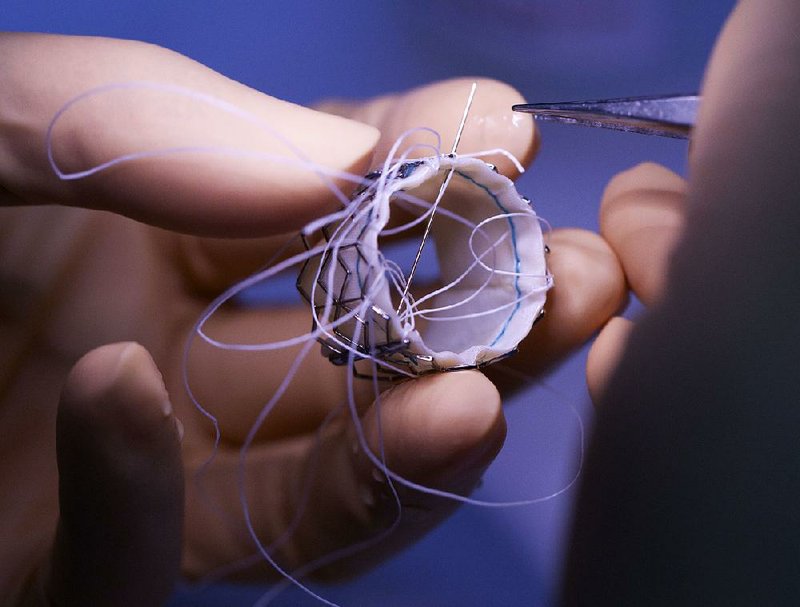New technology that lets doctors insert man-made heart valves with a catheter instead of cracking open a patient’s chest is aiming to change the face of cardiac care for many aging baby boomers.
The procedure, which requires just a 1-inch cut, can require as little as one week of recovery time while recovery from traditional openheart surgery, which pierces the breastbone with a slice that can run the length of the torso, can take as long as eight weeks.
It’s a difference, doctors say, that can make aortic valves made by Edwards Lifesciences Corp. and Medtronic Inc. - designed to use the new procedure - standard issue for heart patients. Medtronic wants to expand use of its valve based on data reported over the weekend at the American College of Cardiology meeting in Washington, D.C.
Medtronic’s CoreValve, which won early approval from the Food and Drug Administration in January, may join Edwards’ Sapien valve in boosting the procedure’s popularity.
The procedure now is “generally used for people that have contraindications to surgery,” said Robert Siegel, director of the Cardiac Noninvasive Laboratory at Cedars-Sinai Medical Center in Los Angeles. “But we keep pushing that envelope.”
The Medtronic device is cleared for patients who can’t undergo open-heart surgery. In the new study, Minneapolis-based Medtronic tested its valve in almost 800 patients who were high-risk but who could have undergone the traditional rib-cracking operation.
If approved for widespread use under such circumstances, the device may join Edwards’ Sapien transcatheter heart valve in what may become a $2.5 billion market annually as other device makers present similar products, said Glenn Novarro, an RBC Capital Markets analyst in New York.
So far, the U.S. market hasn’t taken off as quickly as analysts and investors expected. The number of hospitals trained in the procedure is lower than originally anticipated.
Sales of Sapien, approved in November 2011, have been flat for three quarters. It generated $350 million in the United States in 2013, $50 million less than expected, RBC’s Novarro said.
A second company, though, “especially the size of Medtronic with the ability to go out and educate the general cardiologists, should expand the marketplace,” Novarro said.
“If the patients are there, we just aren’t doing a good enough job getting to them. It’s about educating the cardiologists, who are the gatekeepers, and educating the consumer to let them know there is an alternative to open surgery.”
About 70,000 Americans undergo aortic valve operations yearly to relieve symptoms including chest pain and shortness of breath so severe it can limit everyday activities, according to the Society of Thoracic Surgeons. Doctors historically fixed the problem by opening the chest, cutting out the damaged valve and sewing in a replacement prosthesis.
Though traditional ribcracking surgery may be daunting, the risk of death from it has fallen over the past decade to less than 1 percent for those younger than70, creating a high hurdle for companies developing valves inserted via a catheter.
The Edwards valve was approved for use by all high-risk patients near the end of 2012. Both its valve and Medtronic’s are used in a process that’s considered minimally invasive, inserted mainly via the femoral artery through the groin area or through a small incision between the ribs.
Patients studied in a trial of Edwards’ Sapien had a mortality rate of 24.3 percent compared with 26.8 percent for those having open-heart surgery. The Sapien patients also spent just eight days in the hospital compared with 12 for the rib-cracking operation. While Sapien costs about $30,000, compared with $6,000 for older valves inserted in the traditional manner, patients save by spending less time in the operating room and the hospital, company officials have said.
In examining the Medtronic study, investors, regulators and doctors will look for side effects that may include a higher risk of stroke, an increased need for a pacemaker or high rates of leakage around the CoreValve itself.
If the side effects are acceptable compared with open-heart surgery, the added convenience of the newer procedure may be a big selling point for anyone with damaged aortic valves, said Prediman Shah, a cardiologist at Cedars Sinai Heart Institute in Los Angeles, during a conference call before the cardiology meeting.
“Cardiovascular surgeons should watch out,” said Shah, who is also the meeting’s cochairman. “In the next few years, it’s very likely it will be a relatively rare patient who will have a surgical valve replacement.”
The Medtronic study is one of three focused on the approach at the cardiology conference.
Another compares CoreValve to Edwards’ nextgeneration Sapien XT, while a registry of 7,000 patients examines how those outside of clinical trials fare a year after treatment.
“This is a unique meeting just because we have randomized trials on CoreValve, randomized trials comparing CoreValve to Sapien XT and a huge national registry,” said Cindy Grines, vice president of academic and clinical affairs at the Detroit Medical Center Cardiovascular Institute.
“We’re going to walk away with an incredible body of evidence that could potentially be game-changing,” said Grimes.
Business, Pages 19 on 03/31/2014
